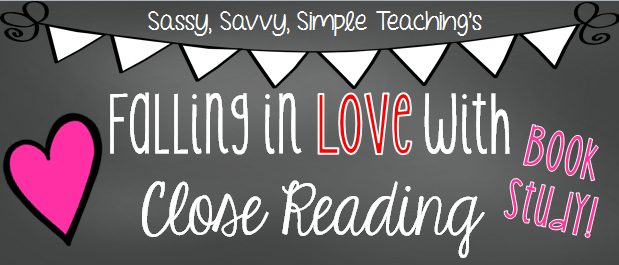Thanks so much for stopping by our book study with Sassy, Savvy, Simple Teaching's!
This week is all about word choice & how words set the tone of the text.
If you missed last week's post about text evidence you can click here.
My Ah-Ha Moments & Comments About Chapter Three
"Words go a long way. In text, in the media, and in our lives, the words we choose matter."
(Lehman & Roberts, 2014 pg. 49)
WOW. Isn't that sentence a show stopper!? There is so much truth in that statement. Not only for reading purposes, but in life. What you say & how you say it matters.
As I was reading I thought, " I could teach this close reading strategy & teach some social skills too."
Chapter 3 is all about how the words give the text a tone and we want our students to recognize not just the vocabulary but, the feeling being set by the author. In other words, we're trying to figure out why the author chose one word over another word. This is taught using the same 3 step process from last chapter, but with a little spin on it so students are focusing on words.
Read Through Lenses
-Choose words from the text that evoke strong emotions & images
Find Patterns
-Which words fit together & how do they fit together?
Develop a New Understanding of the Text
-Think about how those words set the author's tone, purpose, the central idea.
Authors choose words for a reasons. They do this so you feel what the character is feeling.
In non-fiction they use the words to make you feel a certain way about the topic.
In non-fiction they use the words to make you feel a certain way about the topic.
I think you could help students understand this strategy better by bringing it into your writing lesson. Use interactive writing to show how using one word versus another changes the feel/tone of the writing.
When students write on their own in workshop you might ask questions like, "Why did you choose those words in your own writing?" "What emotion or tone are you trying to set?"
Another idea is to take an emotional sentence and change some of the adjectives. Talk with your students about how that changes the tone or feeling of the sentence.
When students write on their own in workshop you might ask questions like, "Why did you choose those words in your own writing?" "What emotion or tone are you trying to set?"
Another idea is to take an emotional sentence and change some of the adjectives. Talk with your students about how that changes the tone or feeling of the sentence.
How is This Strategy Different From How I Teach Close Reading?
I was more focused on teaching the meaning of words, not the tone in my reading instruction. I use tone often when I read on my own, so I'm not sure why I never thought to teach the importance of recognizing it. Perhaps it's because I taught 2nd grade and we're more focused on the basics of reading comprehension. However it is a really important skill to teach. I sometimes forget that we need to model all those strategies that we use automatically in our everyday reading so our students can be successful independent readers.
I'm looking forward to using what I've learned here in my 3rd grade classroom this year.
I'm looking forward to using what I've learned here in my 3rd grade classroom this year.
How do you teach your students to understand the tone of a text?
I'm really enjoying this book! I hope you've learned a bit about close reading today!
Next week we'll learn about the text structure.
Be sure to enter the raffle & check out the other amazing bloggers below to learn more about chapter 3!



No comments:
Post a Comment